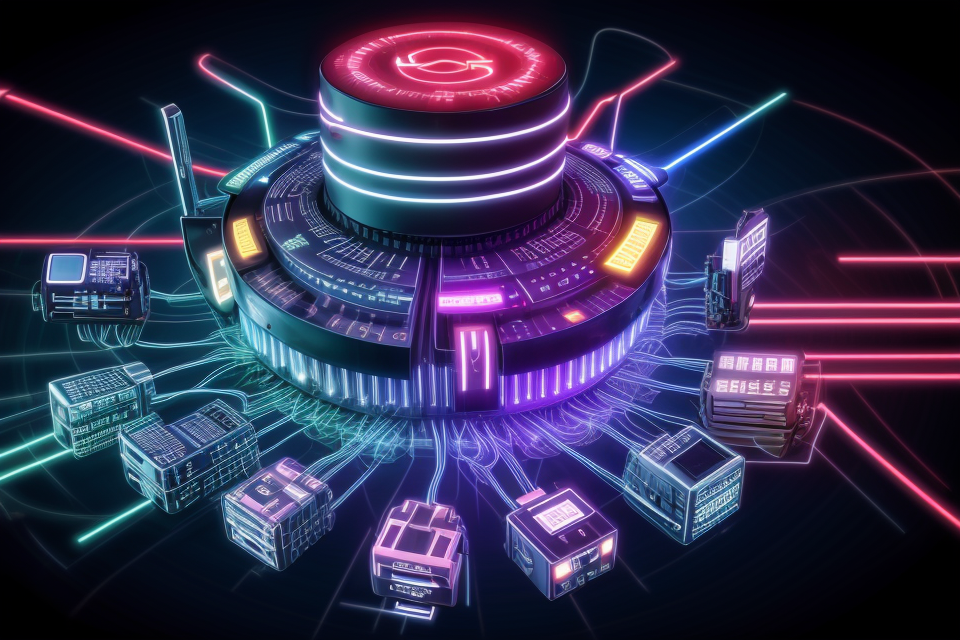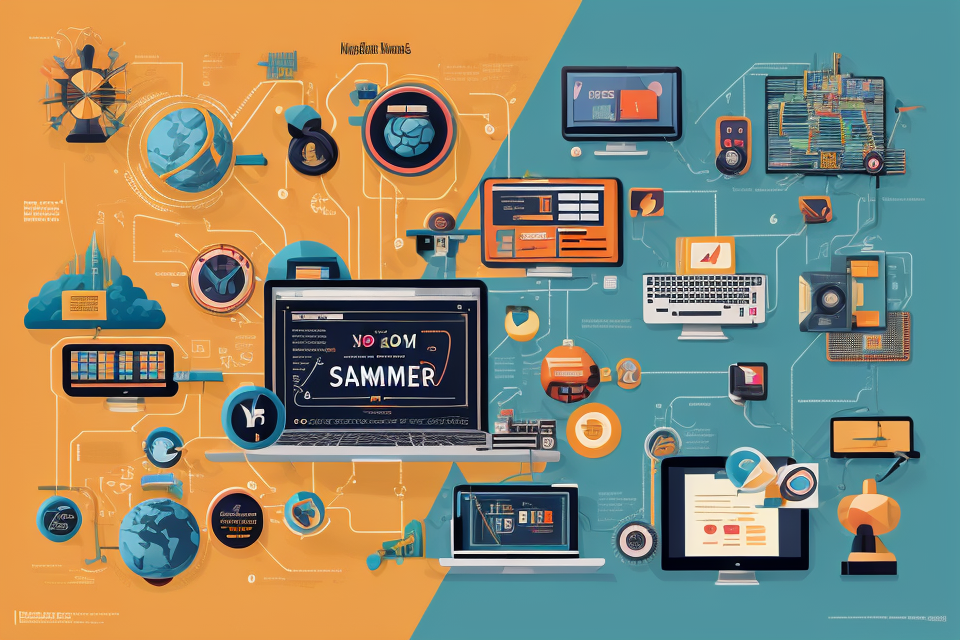The internet is a vast network of interconnected computers and servers that allow people and devices all over the world to communicate and share information. It has revolutionized the way we live, work, and communicate, and has become an essential part of modern life. In this article, we will explore the definition and types of the internet, and how it has evolved over time. We will also discuss the different ways in which the internet is used, and the impact it has had on society. So, let’s dive in and discover the fascinating world of the internet!
The internet is a vast network of interconnected computer networks that allow users to share information and communicate with each other. It is a global system of interconnected government, educational, and private organizations. There are several types of internet connections, including dial-up, DSL, cable, and satellite. Dial-up is the oldest type of internet connection and is typically slower than other types. DSL, or digital subscriber line, is a type of internet connection that uses existing phone lines to provide faster speeds. Cable internet uses the same cables that provide cable television to provide high-speed internet. Satellite internet is a type of connection that uses satellites to provide internet access to remote areas.
Understanding the Internet
What is the Internet?
The Internet is a global network of interconnected computers that enables users to access a vast array of information and resources. It serves as a platform for communication and collaboration among individuals and organizations, allowing them to share ideas, files, and data across geographical boundaries.
History of the Internet
The Internet has a rich history that spans several decades. The first packet-switched network, ARPANET, was developed in the 1960s by the U.S. Department of Defense. It was primarily used for research and military purposes.
In the 1990s, the creation of the World Wide Web revolutionized the Internet, making it accessible to the general public. The rise of social media and e-commerce in the 2000s transformed the Internet as we know it, making it an integral part of our daily lives. Today, the Internet is used for a wide range of activities, including communication, entertainment, education, and commerce.
Types of Internet Connections
When it comes to connecting to the internet, there are two main types of connections: wired and wireless. Each type has its own advantages and disadvantages, and the choice of connection will depend on a variety of factors, including the user’s location, the type of device being used, and the user’s personal preferences.
Wired Connections
Wired connections are physical connections that use cables to connect a device to the internet. There are three main types of wired connections:
- DSL (Digital Subscriber Line): DSL uses existing telephone lines to provide internet access. It is a widely available and cost-effective option, but the speed can be affected by the distance from the telephone exchange.
- Cable Internet: Cable internet uses the same cables that provide cable television service. It is typically faster than DSL, but the speed can be affected by the number of people using the network at the same time.
- Fiber-Optic Internet: Fiber-optic internet uses thin strands of glass or plastic to transmit data. It is the fastest type of wired connection, but it is also the most expensive.
Wireless Connections
Wireless connections do not require physical cables to connect a device to the internet. There are three main types of wireless connections:
- Wi-Fi (Wireless Fidelity): Wi-Fi is a wireless networking technology that uses radio waves to connect devices to the internet. It is widely available and easy to use, but the speed can be affected by the distance from the router and the number of devices using the network.
- Cellular Internet: Cellular internet uses cellular networks, such as those provided by mobile phone companies, to connect devices to the internet. It is a widely available and convenient option, but the speed can be affected by the strength of the cellular signal and the number of people using the network at the same time.
- Satellite Internet: Satellite internet uses satellites orbiting the earth to provide internet access. It is available in remote areas where other types of internet access are not available, but it is typically slower and more expensive than other types of internet connections.
Differences between Wired and Wireless Connections
Wired connections are typically faster and more reliable compared to wireless connections. This is because data is transmitted through physical cables, which do not suffer from interference or signal loss like wireless connections. Additionally, wired connections can support higher bandwidths, which means they can handle more data traffic.
On the other hand, wireless connections offer more flexibility and mobility compared to wired connections. With wireless connections, users can access the internet from anywhere within range, without the need for physical access to a network or modem. This makes it easier to set up and use devices in different locations, such as smartphones, laptops, and tablets.
However, there are some downsides to wireless connections. Since data is transmitted wirelessly, it is more susceptible to interference and signal loss. This can result in slower speeds and dropped connections. Additionally, wireless connections may not be as secure as wired connections, since they can be more vulnerable to hacking and other security threats.
In summary, wired connections are typically faster and more reliable, but offer less flexibility and mobility. Wireless connections, on the other hand, offer more flexibility and mobility, but may be slower and less secure.
Internet Service Providers (ISPs)
What is an ISP?
An ISP, or Internet Service Provider, is a company that provides access to the Internet. These companies offer a variety of services, including email, web hosting, and online storage, in addition to Internet access. The speed, reliability, and cost of an ISP’s services can vary depending on the type of ISP and the specific plan chosen by the customer.
Types of ISPs
There are several types of ISPs, each with its own unique features and capabilities.
- Fixed Broadband: Fixed broadband is a type of Internet service that is delivered through a physical connection, such as a cable or DSL line, to a fixed location, such as a home or office. Fixed broadband is typically faster and more reliable than mobile broadband, but it may not be as flexible or portable.
- Mobile Broadband: Mobile broadband is a type of Internet service that is delivered through a mobile network, such as a cellular network, to a device that is capable of connecting to the network, such as a smartphone or tablet. Mobile broadband is often more flexible and portable than fixed broadband, but it may not be as fast or reliable.
- Satellite Internet: Satellite Internet is a type of Internet service that is delivered through a satellite connection to a customer’s location. Satellite Internet is often available in areas where other types of Internet service are not, but it may be more expensive and have slower speeds than other types of Internet service.
Factors to Consider when Choosing an ISP
When it comes to choosing an ISP, there are several factors to consider to ensure that you get the best service for your needs. These factors include:
- Connection speed: The connection speed is one of the most critical factors to consider when choosing an ISP. The speed of the internet will determine how fast you can download and upload data, and it is essential to choose an ISP that offers a speed that meets your needs.
- Coverage area: Another essential factor to consider is the coverage area of the ISP. It is crucial to choose an ISP that provides coverage in your area, and it is also important to consider the size of the coverage area, as this will affect the reliability of the service.
- Price: The price of the internet service is also an essential factor to consider when choosing an ISP. While it is important to choose an ISP that offers a fast and reliable service, it is also important to consider the cost of the service, as this will affect your budget.
- Customer support: Customer support is another critical factor to consider when choosing an ISP. It is essential to choose an ISP that offers excellent customer support, as this will ensure that any issues are resolved quickly and efficiently. It is also essential to consider the communication channels that the ISP offers, such as phone, email, or live chat, as this will affect the ease of accessing support.
Overall, choosing the right ISP is essential to ensure that you get the best internet service for your needs. By considering these factors, you can make an informed decision and choose an ISP that meets your requirements.
The Future of the Internet
Emerging Technologies
The future of the internet is marked by the emergence of new technologies that promise to revolutionize the way we connect and interact with each other. Some of these emerging technologies include:
- 5G Networks: The fifth-generation wireless technology is expected to provide faster and more reliable internet connections, enabling a wide range of new applications and services, such as virtual reality, augmented reality, and the Internet of Things (IoT).
- Internet of Things (IoT): IoT refers to the interconnection of physical devices, vehicles, buildings, and other objects, which are embedded with sensors, software, and network connectivity, allowing them to collect and exchange data. This technology has the potential to transform industries such as healthcare, agriculture, and transportation.
- Artificial Intelligence (AI): AI is increasingly being integrated into the internet, enabling new applications such as personalized content recommendations, predictive analytics, and intelligent chatbots. AI also has the potential to improve cybersecurity by detecting and preventing threats.
Challenges and Concerns
As the internet continues to evolve, it also faces new challenges and concerns. Some of these include:
- Cybersecurity threats: With more devices and data being connected to the internet, the risk of cyber attacks and data breaches is increasing. Cybersecurity threats range from malware and phishing attacks to sophisticated cyber espionage campaigns.
- Privacy concerns: As more personal data is collected and shared online, concerns about privacy are growing. Individuals are increasingly aware of the risks of having their personal information compromised, and governments are introducing new regulations to protect user privacy.
- Digital divide and accessibility issues: Despite the many benefits of the internet, not everyone has equal access to it. The digital divide refers to the gap between those who have access to the internet and those who do not. In addition, people with disabilities may face barriers to accessing and using the internet. Addressing these issues is crucial to ensuring that everyone can benefit from the opportunities offered by the internet.
The Importance of Staying Informed
- Keeping up with new technologies and trends
The rapid pace of technological advancements in the field of the internet makes it essential to stay informed about new developments and trends. By staying up-to-date with the latest innovations, one can be better prepared to take advantage of the opportunities presented by the ever-evolving digital landscape. This knowledge can also help individuals and businesses stay competitive in their respective industries. - Understanding the potential impacts on society and the economy
As the internet continues to play an increasingly significant role in our lives, it is crucial to comprehend the potential implications on society and the economy. Staying informed about the impact of emerging technologies and trends can help individuals and organizations make more informed decisions that align with their values and goals. It also allows them to anticipate and adapt to any potential challenges or opportunities that may arise. - Ensuring equal access to information and resources for all individuals
In today’s digital age, access to information and resources is vital for individuals to thrive. By staying informed about the latest advancements in the internet, one can help ensure that all individuals have equal access to the tools and resources they need to succeed. This includes promoting digital literacy and access to high-speed internet in underserved communities, as well as advocating for policies that support a more equitable digital future.
FAQs
1. What is the Internet?
The Internet is a global network of computers and servers that are interconnected and can communicate with each other using various protocols and technologies. It allows users to access and share information, communicate with others, and access a wide range of services and resources.
2. What are the different types of Internet connections?
There are several types of Internet connections, including:
* Dial-up: a slow and outdated connection that uses a phone line to connect to the Internet.
* DSL (Digital Subscriber Line): a faster connection that uses a phone line to provide high-speed Internet access.
* Cable: a fast and reliable connection that uses a cable modem to connect to the Internet.
* Fiber-optic: a very fast and reliable connection that uses fiber-optic cables to provide high-speed Internet access.
* Satellite: a connection that uses a satellite dish to connect to the Internet, typically used in remote areas where other types of connections are not available.
3. What is the difference between the Internet and the World Wide Web?
The Internet is a network of computers and servers, while the World Wide Web (WWW or Web) is a system of interconnected documents and other resources, including websites, that are accessed via the Internet. The Internet provides the infrastructure for the Web, but the Web is just one of many services that can be accessed over the Internet.
4. What is the history of the Internet?
The Internet has its roots in a network called ARPANET, which was developed in the 1960s by the U.S. Department of Defense. ARPANET was initially used to connect computers at military and research institutions, but it gradually expanded to include other types of organizations and individuals. The modern Internet was born in the 1980s with the development of the TCP/IP protocol, which allowed different types of computers and networks to communicate with each other.
5. What are some important concepts related to the Internet?
Some important concepts related to the Internet include:
* IP address: a unique numerical identifier assigned to every device connected to the Internet.
* Protocol: a set of rules and standards that govern the communication between devices on the Internet.
* Browser: a software application used to access and display websites and other resources on the Web.
* Search engine: a tool that helps users find information on the Web by searching for keywords and other relevant terms.



